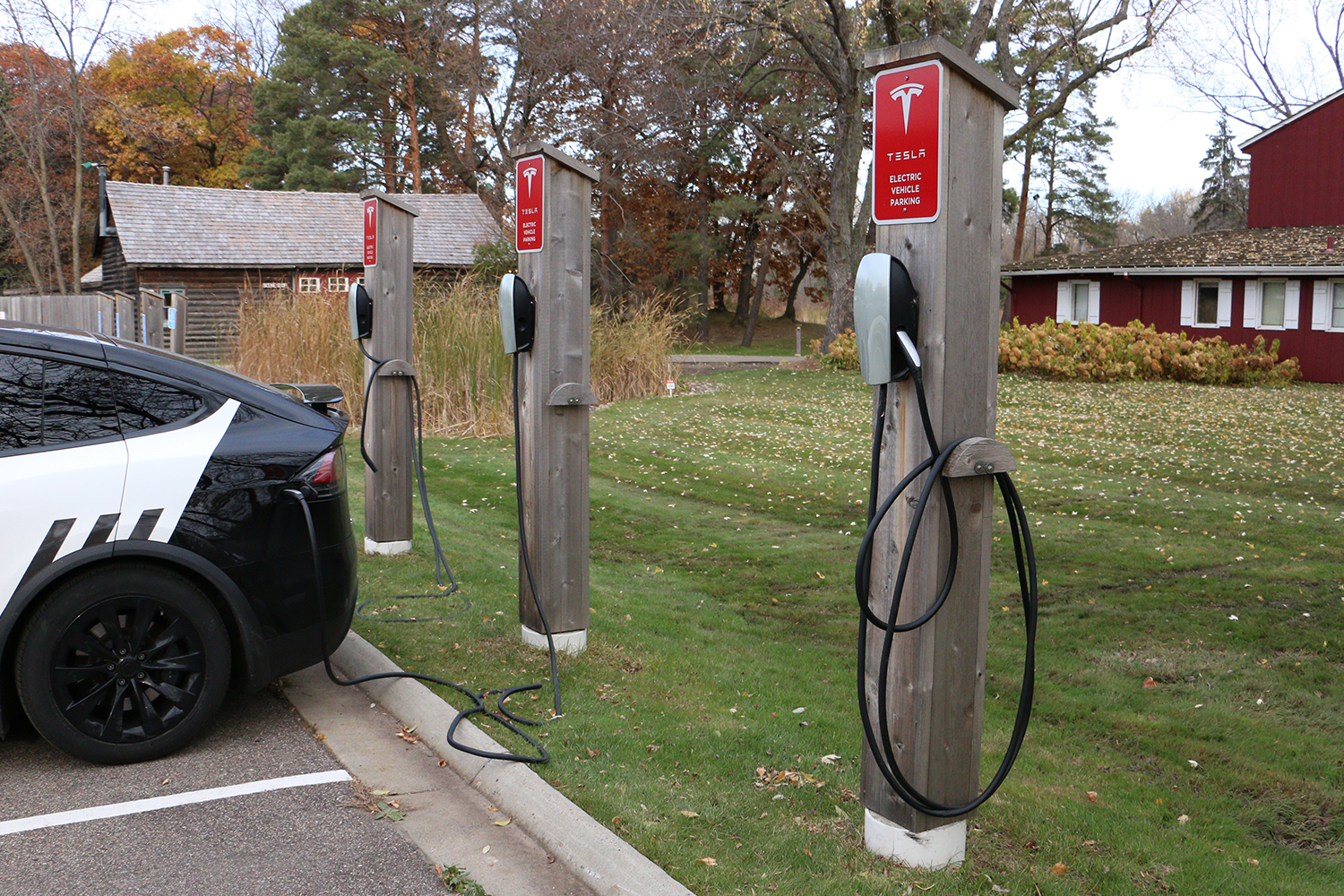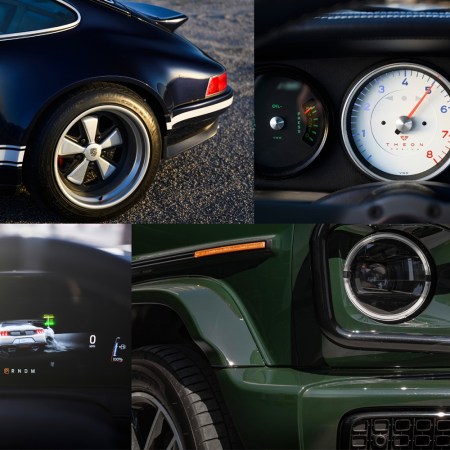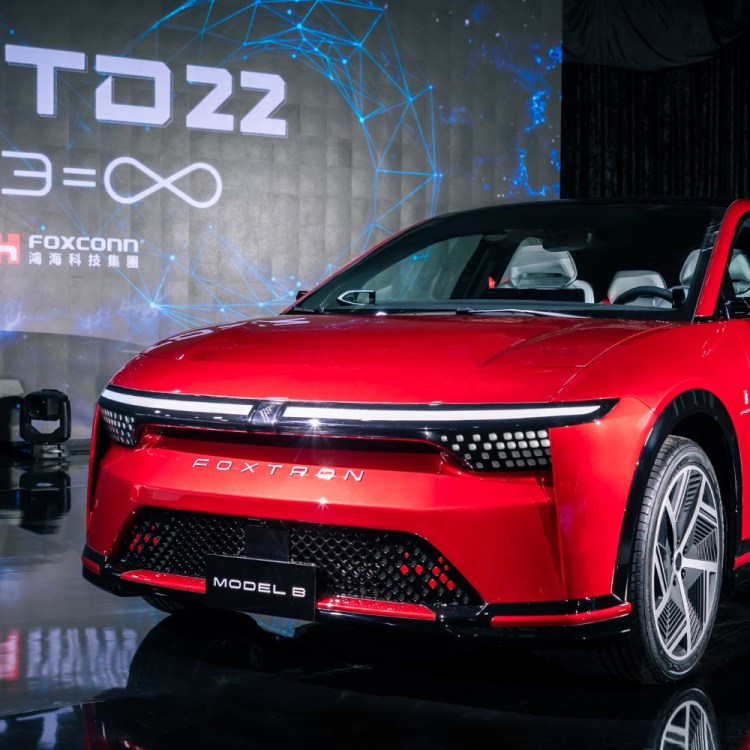
It was supposed to be the dream electric-vehicle getaway.
I had a fully charged, candy-apple red Tesla Model 3. It was peak leaf-peeping season in Minnesota. My girlfriend and I were heading from Minneapolis to Duluth on a Friday after work, a drive we could make in under three hours without stopping to charge. But we did stop halfway, pulling into one of the eight empty Supercharger spots at Tobies, one of those musty roadside restaurants with caramel rolls as big as a rotisserie chicken. The purpose of the trip was to experience EV charging for ourselves, after all.
Our destination was Larsmont Cottages, a swanky resort right on the shores Lake Superior just a half hour north of Duluth. We have two Tesla charging ports, they said. We don’t get many electric vehicle owners, so charging at night won’t be a problem, they said. Then Saturday night came.
It turns out Two Harbors — a town with a population under 4,000 — doesn’t have many dining options, so after a failed attempt at partaking in local culture we ended up at the hotel restaurant, parking the Model 3 in front of the main building. Afterward, in the pitch black, we drove around the resort back to our cottage, the wind picking up and the temperature dropping to the 30s, only to find the nearest charging port blocked by a Land Rover and a Ford F-150.
No problem, I thought. We’ll just hook up the car to the second charger on the other side of the resort and walk back. So we U-turned to the main drag, drove past rows of quiet cabins and full parking spaces, then sucked in our breath: there was the second Tesla charger, glowing green in the darkness, completely blocked by a row of gas-powered cars. We were under a 20-percent charge and needed to drive back to Minneapolis the next morning.

Thankfully, there was one more charger available, a non-Tesla-specific high-powered option from a company called ClipperCreek, and we had an adapter to fit it into our Model 3. But because of the rule of threes, even though the charging port was in a completely empty gravel lot not meant for guests, the parking space next to it was occupied by a Jeep Wrangler. But I needed to charge, internal combustion engines be damned, so we did what any respectable EV driver would do: parked askew on the grass (sorry, Larsmont), plugged in and hoofed it back to our warm lodgings, leaving the Tesla looking like we had stolen and abandoned it.
If charging a zero-emissions electric vehicle is that much of a hassle under even the most ideal of conditions, how can we expect Americans to switch their gas guzzlers for EVs on a national scale?
Who’s Afraid of EV Charging?
Every day, more and more electric vehicles hit the road in the United States. In a country built to serve the automobile and a world confronting a climate crisis, the zero-emissions vehicles seem to be the inevitable future of transportation. Of course, the challenges of switching over are many and varied, from automakers trying to figure out how to design cars that look and perform the same but are powered completely differently, to educating people about new technologies (like the difference between a gallon of gas and a kilowatt-hour), to emotionally uncoupling drivers from the sound of an internal combustion engine. But the biggest problem rearing its head is something we are all familiar with on a much smaller scale: charging.
According to a 2019 AAA survey, the biggest deterrents to buying an electric vehicle all concerned charging. Respondents worried about the lack of places to charge, the prospect of running out of power, and EVs not holding enough of a charge for long-distance driving. Another survey this year (this one conducted by Harris Poll on behalf of Volvo) found that among non-EV drivers, the factor most likely to convert them would be the presence of more charging stations.
This criticism — a lack of perceived charging options — may come from a place of ignorance, or simply from a failure to adequately inform the consumer market. But when you look at the plans that automakers have for electric vehicles, one can’t help but wonder: How in the world are we going to power all of these cars when they finally start to hit the streets in force?
“When you look at market penetration for EVs, we’re still at about 2% [in the U.S.],” Darryll Harrison, Senior Director of Global Communications and Social Media at ChargePoint, told me. And despite recent lukewarm sales numbers, BloombergNEF expects adoption to skyrocket in the coming decades. In their global Electric Vehicle Outlook 2019 report, the research group has two projections that will put anyone concerned about charging on edge: the number of internal-combustion passenger vehicles sold in a year has already peaked, and the share of EV sales in the U.S. will reach 60% by 2040.
Is that even possible? If you take a look at the plans for every major automaker, it seems to be the goal. Last month, Volkswagen announced a mind-boggling five-year budget of $66 billion for electric vehicles and other emerging technologies, and back in August, Cadillac President Steve Carlisle told The New York Times the brand’s entire lineup would be electric in six to 10 years. The Wall Street Journal reported a similar trend, saying both VW and General Motors were cutting out hybrid plans to fast-track their all-electric vehicles, with the latter planning “to launch 20 fully electric vehicles world-wide in the next four years.” And that’s not even mentioning Tesla, which has so far walloped the rest of the industry in battery-electric vehicle sales.
Rebuilding the automotive industry isn’t the problem — we have the technology. What BloombergNEF and other research firms see as one of the biggest roadblocks to EV production is exactly what consumers are worried about: charging. According to their 2019 report, EV adoption is projected to slow down “in the 2030s as charging infrastructure availability holds back the market.”
But as we’ve learned all too well in this country, predictions, research and polls can only get us so far. To take a look at what the state of EV charging truly looks like — and whether or not it’s going to be ready in the coming years — I sought out the people who are already living in the electrified future, from executives in the automotive and charging industries to early Tesla fanboys to the people running the stations where I charged my loaner Model 3.
Electric Cars Are Not Gas Cars. I Repeat …
If you take nothing else away, the most important thing to learn about electric-vehicle charging is that EVs are not the same as gas cars. Why am I starting with this? Because just about every person I talked to reiterated it over and over. It seems obvious, but it’s not something most Americans truly understand. Take this recent statistic from Ford: “Forty-two percent of Americans think electric vehicles still require gas to run.” It may seem ridiculous to the EV-literate, but it’s where we find ourselves.
When I chatted with Darryll Harrison of ChargePoint, the holistic EV charging company responsible for the world’s largest charging network to date (currently over 105K plugs, mostly in North America), he insisted on getting this point out of the way before I asked any other questions, since it would frame the entire discussion. Harrison has worked at every level of the automotive industry, from big names like Nissan, Kia and Volkswagen to smaller startups like Coda Automotive, and he says that being immersed in a leading EV company has entirely changed his perspective on what it means to own a car.
“One thing that I found when I made the switch to ChargePoint is the understanding of how people engage with and use electric vehicles is very, very different than the way that they engage with gas cars,” said Harrison. The operative word there is “engage.” People who have never owned an electric vehicle think they will use them the same as a gas car, but that’s not what ends up happening. “The psychological culture of having a gas station on a corner, being able to see it, registering it in your brain that when the light comes on in my car, then I will go drive somewhere and put fuel in it — it’s a behavior that’s been learned over more than 100 years, and it’s something that isn’t going to change overnight.”
If electric cars are not like gas cars, is there a better comparison in terms of technology the average person uses in their everyday life? “It’s actually more similar to charging your mobile device,” said Harrison. “The beauty of driving electric and the beauty of charging one is that virtually any parking spot can be a place to fuel. You can’t put a gas pump in your garage, but you can put a charging station in the garage. As a result of that, oftentimes charging an EV is opportunistic, meaning that I’m going to charge my car where my car is going to be anyway.”

That is exactly how it ended up playing out on my personal Tesla road trip. For all the frustration I felt on the Saturday night, when my Model 3 was — in phone parlance — in the yellow, it wouldn’t have ultimately mattered if I charged overnight or not. Because on Sunday morning, before we drove back to Minneapolis, my girlfriend and I stopped at Gooseberry Falls State Park. The parking lot was getting full, but there were two prime spots right next to the trailhead that were empty — because they were reserved for electric vehicles. I could have charged enough during our hike to get back to the Supercharger at Tobies, where we stopped to grab coffee, and that would have charged us up enough to get all the way back to the city without spending any extra time waiting around.
The State of EV Infrastructure in America
The problem with using my weekend road trip as a model for what charging is like is that EV owners tend to do most of their charging at home. Beyond the idea of EVs not being the same as gas cars, this was the claim repeated to me most often.
“We’re on our third EV at my household, and I think charging out in the wild is something we do five percent of the time or less,” Dan Edmunds, Director of Vehicle Evaluation at the popular automotive resource Edmunds, told me over the phone. (Those vehicles, by the way, were two Fiat 500es, which couldn’t support DC fast charging, and a new Volkswagen e-Golf.) According to the U.S. Department of Energy, most EV drivers “do more than 80% of their charging at home.”
Edmunds’s job requires him to test drive just about every passenger vehicle imaginable, so the fact that he’s an early EV adopter says something. What it doesn’t say is that he thinks everyone, everywhere should buy electric, or that our charging infrastructure in the U.S. is remotely ready for universal acceptance.
“I think an EV as an only vehicle for an individual, with no other vehicle, is a tough sell anywhere,” Edmunds said, adding that he is a homeowner with a gas-powered vehicle he uses for longer trips. He made an exception for Tesla, whose Supercharger network offers the most comprehensive DC fast charging in the country, but also said the growing Electrify America platform is making a huge difference. (Electrify America, if you don’t know, is a 10-year, $2 billion EV infrastructure project from Volkswagen that is part of their atonement for their 2015 emissions scandal.)
Tesla Superchargers. Electrify America. DC fast charging. It’s a lot to take in and understand (again with the education gap), so here’s a crash course before we move on:
There are three types of charging available at the moment: Level 1 and Level 2 (which are the most common types available for your home), and Level 3 (more commonly known as DC fast charging). From the slowest to the fastest, Level 1 can go through a regular 120V outlet, Level 2 needs a 240V outlet, and DC fast charging is what you’ll find at Tesla Supercharger stations, and increasingly at stations from its competitors (Electrify America and ChargePoint, among others). Not all EVs are equipped to handle DC fast charging (Edmunds’s Fiat 500e, for example); there are various plugs available for different charging levels, stations and vehicles, but for the most part they can be adapted to each other, with the exception of Tesla Superchargers, which are only compatible with Tesla vehicles. At present, the U.S. Department of Energy lists about 23,600 public Level 2 and Level 3 charging stations in the country in total (that’s entire stations, not the number of individual plugs at the stations, which is much higher, and a point we’ll get to in a second).

Looking at the map of the U.S. for yourself, you’ll see some obvious gaps. That’s because the rollout strategy has not been developed by one overarching organization with multiple companies contributing, but rather by multiple companies independently to serve their own needs. While Tesla has been a leader in the production of electric vehicles themselves, they’ve also beaten the competition in both the charging infrastructure and the layout of that infrastructure. The Supercharger network, which currently consists of 1,636 stations and 14,497 individual chargers, has been strategically placed across well-traveled paths throughout the country.
In effect, while most electric vehicles previously had limited capabilities when it came to long-range travel, confining people to city centers or at least a defined radius from their garage charger, Tesla was able to offer greater automotive freedom much earlier than competitors. As a Tesla spokesperson told me, the Supercharger network gives Tesla drivers the confidence their cars can do everything they want a car to do.
It let me travel to Duluth without a hitch, it let Edmunds drive from California to New York and back in a Tesla, and it was the best reason to buy a Tesla over every other electric vehicle, until recently.
“As we’ve seen this past Thanksgiving, now that there are enough Model 3s on the road, the Tesla Supercharger network is becoming oversubscribed on heavy travel days,” said Edmunds. If you don’t know what he’s talking about, a video recently went viral (as much as EV charging videos can go viral) of a line of Teslas in San Luis Obispo, California, waiting to charge. It’s an outlier for sure, but it does get to the heart of the matter: Is this a sign that charging infrastructure is failing to keep up with demand?
The Cracks Already in the Pavement
In speaking with drivers, automakers and charging professionals, there were two problems that kept cropping up in terms of the future of the electric-vehicle network in the U.S.: a general lack of available public chargers throughout the country, and a more specific lack of chargers for people who park on the street, especially in urban areas.
The Thanksgiving debacle that Tesla saw can be anecdotally explained away because of the high level of EV adoption in California. But Ryan Fisher, an associate in the electrified transport team at BloombergNEF, put it into a larger context by comparing the U.S. to other parts of the world.
“The amount of charging infrastructure in the United States has lagged [behind] that of Europe and China, with only 65,000 charge point connectors in comparison to 235,000 and 400,000 respectively as of June 2019,” said Fisher. (This goes back to that part about there being roughly 23,600 charging stations in the U.S., but more connectors.) “This is around 20 electric vehicles per public charge connector in the U.S., in comparison with around seven vehicles to a connector in Europe and China.” While the U.S. has been a leader in electric vehicles, we are already starting to slip away in terms of the energy sources needed to make those vehicles viable.
As Fisher notes, “[Oil and gas companies] have heavily invested in charging infrastructure companies and deployment of infrastructure on forecourts in Europe, but due to less political pressure and also ownership of forecourts, there have been limited announcements on charging infrastructure by oil and gas companies in the United States.” When we’re talking about oil and gas companies partnering with “zero-emissions electric vehicles,” things get murky. For example, here in the U.S., Shell Oil bought the charging company Greenlots, but they declined a request to comment for this article.
Another part of the problem, though, goes back to Tesla’s dominance — or at least the savvy marketing campaigns that have led consumers to believe as much. We’ve been told over and over that Tesla has left all its competitors in the dust, but those competitors have caught up in terms of comparable technology. The issue now is implementation.
“Electrify America expects to install or have under development approximately 800 total charging stations with about 3,500 chargers by December 2021. During this period, the company will be expanding to 29 metros and 45 states, including two cross-country routes,” Rich Steinberg, Senior Director of Green Cities, Marketing and Communications at Electrify America, told me via email. As for ChargePoint, Harrison said that “by 2025, we anticipate that we will be somewhere in the neighborhood of 2.5 million places to charge, split evenly between Europe and North America. And then obviously beyond that, it’s going to continue to increase.”
That covers home charging (which is already available in your garage) as well as destination charging. But what about those who don’t have a garage, either because they park on the street or simply don’t have a means to charge at home? In other words, what about car owners who live in cities?
“I think [buying an EV] is a very different proposition for a homeowner than it is for somebody who’s renting, who doesn’t have access to charging where they live,” said Edmunds. He thinks of it like a chicken-and-egg issue: there needs to be a huge increase in the purchase of electric vehicles for chargers to appear on every street corner, and yet those chargers need to be there for anyone who parks on the street to consider buying an EV.
Even Tesla admits that’s a blindspot in their work so far, and something they hear all too often from customers. As a solution, they mentioned charging at work instead of at home, as well as the Superchargers they’ve been rolling out in urban areas (especially for charging in the mid-range — i.e., not from 0% or to 100%). But in the end, the best they could give me was that it’s a work in progress. And to be fair, no one else had a satisfying answer to this problem, either.
Admittedly, this feels like a potentially crippling problem, and one that ties directly into the fact that until now, electric vehicles have generally been priced as luxury vehicles, and you kinda-sorta need a garage with your own charger to own one. But BloombergNEF’s report notes that they “expect price parity between EVs and internal combustion vehicles by the mid-2020s in most segments.” As for the garage issue, there are plenty of startups hard at work on ways to install chargers throughout urban areas, like Germany’s Ubitricity, which tested street-lamp chargers in New York City.
At its core, though, the issue here is an extension of Harrison’s comment about rethinking how we use EVs on a fundamental level. If there are sufficient fast chargers in a city to allow people to top up whenever and wherever they need throughout the day, do we really need chargers on every single residential city block, too?
Related:
Can High-Speed Trains Solve America’s Transit Crisis?
What Are Carbon Offsets, and Should You Buy Them When You Fly?
It’s Time to Take Buying an Electric Scooter Seriously
There are other, less obvious problems that are only blips on our radar right now, but will have to be accounted for sooner or later, like the wildfire-induced blackouts in California that left EV drivers to their own devices this fall. Other issues come down to who is ultimately paying for the wattage, like one I encountered while speaking with Troy Melichar, the general manager of Larsmont Cottages.
“A few of our owners — because our property here is individually owned — have said, ‘So now we’re paying for our guests to charge their car so they can come up here?’ Which is a little bit of a controversy,” said Melichar, alluding to the fact that all three chargers at Larsmont are free to use. “I wouldn’t say a lot of controversy, but I’ve heard it a little bit from the owners: ‘Well no one pays for my fuel to get from point A to point B.’”
Melichar didn’t tell me what type of people were complaining, but from the tone, I’d bet they were all dads. So I’ll leave it to another dad to respond. Greg Frankenfield, CEO of Minnesota digital technology firm Magenic, as well as one of Tesla’s earliest drivers (he bought a Roadster with his brother in 2012, and now owns a Model S and X, too), reminded me that just as gallons of gas don’t equate to kilowatt-hours, gas prices don’t equate to electricity prices.
“I spend probably $30 a month on electricity, versus a couple hundred for people who drive gas vehicles,” he said. During our conversation, Frankenfield also brought up the point of potential electrical grid overload, which is something I asked multiple interviewees. They all gave me essentially the same response: “You have to recognize our electric power usage in the United States is actually dropping despite what you might read or hear … and utilities are not happy about that, because they sell electricity.”
So Where Do We Go From Here?
The reason I wanted to talk to Frankenfield is not because he’s an influential CEO, and it’s not because he bought a Model S early enough that he was given a tour of Tesla’s factory, either. It’s because when I took out the Model 3 for the weekend, the one place I wanted to stop to charge was the Old Log Theatre in my hometown of Excelsior, Minnesota.
Greg and his wife Marissa bought the theater back in 2013, and when I moved back to Minnesota from New York this summer, one of the first changes I noticed in the quaint lake town of some 2,000 people was that there were now three Tesla destination chargers in the parking lot of the Old Log. We’re talking about an historic theater that looks like a barn tucked away between two bays of Lake Minnetonka where I once went for an elementary school field trip — now with red Tesla chargers to match the red barn. In other words, it was the last place I expected to find EV charging.

When I asked Frankenfield why he decided to install the chargers, he mentioned Tesla did it for free after he applied, just like they did at Larsmont Cottages. And he also mentioned “the minor business justification” as well as the potential for getting some free press (guess he got me there). But after rambling through those talking points, he hit on something bigger: “I’m a Tesla fan and I’m an electric-car fan. Actually, I’m a fan of all the electric cars, and I think it’s important that we move in that direction … So I’m doing what I can to support it.”
After combing through all the interviews I conducted, I still stand by the fact that the most common ideas directly and openly presented to me had to do with educating the public about EVs and home charging. But indirectly, the most pervasive feeling that I found in my conversations is what Greg stumbled upon here: there is a camaraderie and passion in the electric-vehicle world that is hard to understand from the outside, but it is one of the most convincing reasons to believe the U.S. can handle any EV problem that comes its way. This goes beyond Elon Musk fanboys and tech nerds: all the industry professionals I spoke with were open to collaborating with anyone, whether friend or commercial foe.
When I asked Alex Keros, Lead Architect of EV Infrastructure at General Motors, about the infrastructure problem via email, he was unflappable: “Yes, America will be ready,” adding that the “challenge comes in ensuring the new system is thoughtfully designed (and all stakeholders are actively engaged with each other).” On that front, GM is already actively engaged with ChargePoint, EVgo and Greenlots, among others.
Harrison of ChargePoint reiterated that point, saying, “We think that if charging is more accessible, whether it be through charging on our network or through charging in another network, as long as more access to charging is available, we think that that is a tide that lifts all boats.” And as much as Tesla seems like a lone wolf, during one of the company’s quarterly earnings calls in May 2018, CEO Elon Musk said he’d be willing to open up the Supercharger network to other vehicles.
Of course, there are issues that haven’t been covered here, and there are difficulties the industry is yet to consider. And while just one weekend spent in a Model 3 convinced me and my girlfriend that, despite living in an apartment and parking on the street, we could 100% figure out a way to get an EV and keep it charged, I understand if you don’t feel the same way. You might need more convincing, more assurance, a better safety net.
But when I posed my question about our country’s readiness for electric vehicles to Frankenfield, he gave me the most American answer of all:
“It’s not a concern. Make the problem. We’ll figure it out.”
This article appeared in an InsideHook newsletter. Sign up for free to get more on travel, wellness, style, drinking, and culture.






















